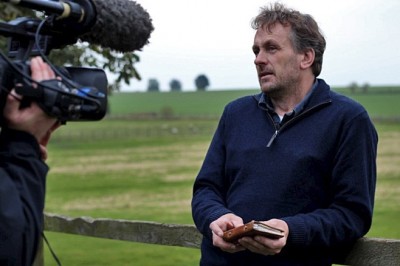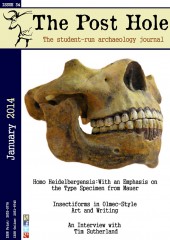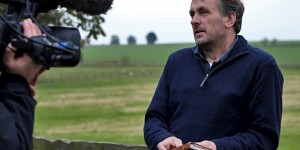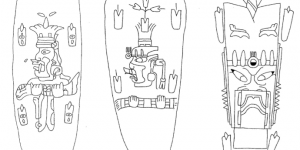Tim Sutherland, a battlefield archaeologist, talks about his recent TV series Medieval Dead as well as current archaeology projects he is working on, including his project at Towton.
We’ll start with some background on your academic career. Where did you study?
One day whilst working as a qualified joiner I became somewhat disillusioned and walked into the Jobcentre - there was an offer to be a trainee archaeologist for a year, and so I took it. I was then accepted at York for an undergraduate course, but decided that I would initially prefer to study for a more practical qualification and so did a two year HND in Practical Archaeology in Dorset. After specialising in geophysical survey I later went to Bradford to do a degree in BSc in Archaeology and in 1995 an MSc in Archaeological Prospection and Geophysics. In 1996, developers discovered a mass grave of combatants from the 1461 Battle of Towton and so I joined a group of osteologists from Bradford University to excavate the burial site. As I then had a great deal of archaeological experience I ended up helping to run the site, along with the osteologists, one of whom was Malin Holst (an osteologist now at the University of York). We supervised the systematic removal of the skeletons and the survey work and this lead on to the start of my PhD in 1997.
Tell us more about your research at Towton.
After we uncovered the mass grave we needed to put the grave into the battlefield context and so I started my part time PhD related to this subject. This involved finding archaeological evidence of the battle itself. As I researched the project I realised that no one had carried out a formal multidisciplinary battlefield archaeology survey before in the UK, which was rather surprising given that in the USA battlefield archaeology was an acknowledged discipline.
What research has been carried out so far at Towton?
Following the start of the project I investigated many of the acknowledged sites associated with the battle which took several years. These were almost all found to be erroneous. I was therefore removing rather than recovering, what was formerly accepted to be the evidence of the battle. At the same time I began working with a metal detectorist, Simon Richardson who had been detecting the site for many years. Any artefacts he found he had been locating approximately on a sketch map of the site. I therefore asked him if he would record them more accurately which he then did. In 2003 after discussions relating to artefact distribution patterns on the site we determined he should search in a certain artefact rich area. It was then that he found his first arrowhead. Now we have over 350. Just before 2005, we then found some human small remains on the surface whilst geophysically surveying this area. We excavated a small test pit and found that they marked the site of the mass graves in the middle of the battlefield. These graves now await further evaluation as to how big they area and how many there are in that location. In 2010 we instigated the Towton Battlefield Landowner Agreement, which meant that all the relevant landowners gave permission to ban unauthorised metal detecting on their land. It’s been very successful and is the first of its kind in this country. It’s something I’ve considered for years, due to problems of unauthorised metal detectorists not recording their finds. The work now progresses in selective areas. Latterly, the project has been involved in the TV series Medieval Dead, with our continued and successful hunt for King Richard III’s chapel.
Has there been other TV involvement at Towton?
There has been a great deal of interest in Towton since we recorded the mass grave. In 1997 I help make a programme with the Royal Armouries. In 1999, the documentary Blood Red Roses was filmed for Granada Television, which won an archaeological television award and, at the time, had bigger viewing figure than Time Team. This came out just before the book on the mass graves was published, hence the name for the book, Blood Red Roses!
How did Medieval Dead come about?
I’ve known Jeremy Freeston, the director of the Medieval Dead series, for many years, and he liked the format of the Blood Red Roses programme, which thus sparked Medieval Dead. He rang me up with the concept of the series and used my research projects and contacts to make it a reality: Towton, Agincourt, Visby, Masterby and Tadcaster. Jeremy wanted to use the forensic application of archaeology in the series, which is why we use the scientific evidence whenever possible and engage renowned academics such as Professors Charlotte Roberts and Anne Curry, who are experts within their own field.
Is Medieval Dead the first big TV series for you?
I’ve maybe had 20 or so TV appearances since I first worked at Towton and this has made me more aware of how archaeology is portrayed on TV. But Medieval Dead was the first series that I’ve had a major involvement with.
What other countries has Medieval Dead been shown in, and what was the reception like?
The series was first shown in Sweden, before it was even finished, and then in Australia and New Zealand. However, it hasn’t been shown in America yet and the reception it receives there will be important. We’ve had good feedback so far, and the series has been generally well received. There have been a few negative comments but that’s what happens. We get slight criticism that the programme is a bit watered down, but it’s for television so it has to be viewer-friendly, and the series was also made on a very tight budget.
With the televising of Medieval Dead and the recent Time Team special on the Battle of Hastings, do you think battlefield archaeology is becoming more popular with the public?
It is, but it is also simply not about it being popular, it’s important that battlefield archaeology is seen as normal, in the way that geophysical survey is now regarded as an accepted part of archaeology. I feel that it’s something that’s necessary in the field of archaeology.
Over what length of time was Medieval Dead filmed?
Medieval Dead was filmed over a year and a half and it was a rush to get it finished! I initially didn’t think we’d get the go ahead to do it at all. As the series was being shown in Sweden before the series had been finished, this meant that the Mästerby episode did not contain all of the final results when it was broadcast.
Would you do another series?
Certainly. Another series of Medieval Dead is planned but as I’ve run out of my current research projects and so I need to look at some other projects that I have been, or would like to be involved with.
Any other future TV projects?
Jeremy, the director wants to do some work at Waterloo for the 200th anniversary. We have another programme planned for the 600th anniversary of the Battle of Agincourt in 2015 and we are potentially covering archaeological work on another battlefield in Portugal and an early medieval battlefield and mass grave near Chester.
Do you have any control over the end product of the TV show?
I get some say during the filming and I am able to state what I do and do not approve of. In the end, it is a compromise that has to be made. It is, after all, television.
How do you find working with archaeologists abroad and what reception do you receive?
It varies, some countries are very accommodating. Gotland was wonderful and the people very hospitable. On Gotland there are sheep that have silver-like fleeces that are very expensive. The locals realised that I was going to buy one and gave me a fleece as a thank you for helping them with the project and for getting others involved in their work. But in other areas it is different. In some countries the bureaucracy almost inhibits successful archaeological work. When working abroad, you have to take care how you represent yourself, the university and one’s own organisation. Wherever you go, you find there are issues that tend to arise and have to be dealt with sensitively, for example attitudes towards metal detecting or human remains.
How do other countries regulate metal detecting?
Portugal, for example, does not permit the ownership or the use of metal detectors. This is acceptable to a point although archaeological work suffers because of it. Battlefield Archaeology as we understand it does not exist there. In Sweden, metal detecting is regulated and requires a permit. However, the EU laws are potentially going to be relaxed, down to UK levels, which, I feel would be a mistake.
What is the future of UK battlefield archaeology?
In Americans battlefield archaeology is generally well accepted, especially by the government as all National Parks do not permit random detecting. The UK is playing catch up. The Germans started relatively recently but have caught up with us, and in some cases are even surpassing us! We should be utilising metal detectors as valid archaeological survey techniques and regulate metal detectorist more successfully. There is still so much to do in the country regarding the protection of our battlefield heritage.
Do Americans come over here to research?
We try to liaise with our American colleagues whenever we can. Some of my colleagues go over there and sometime they come to see how we do things here. However, some people come from all over the world to exploit our poor heritage laws. We are currently part of a small discipline worldwide which encourages helpful association in all these respects.
Is battlefield archaeology easier in the USA?
Yes, they have a relatively shorter military history and so they can focus on a shorter time frame, most of which is dominated by lead shot and bullets from the War of Independence or the American Civil War. These are much easier to find than, for example, medieval arrowheads. But, even so, there are hundreds of battlefields within that shorter time frame.
What other projects are you currently involved in?
I’m currently involved in a project on the Battles of Lewis (1264) and Evesham (1265). Both involved Simon De Montfort, who instigated Parliamentary democracy, and who won the first and was killed at the second. I currently want to do more work at Evesham and might even be able to make a television programme about the site. I’ve also been involved as an advisor with the Battle of Lützen (1632) Germany, where they began to carry out a 100% metal detector survey on the battlefield – experts were brought in from around Europe. The initiators of this project were desperate to locate the mass graves and we eventually suggested that they might be in a certain location. An open area excavation was carried out and they found a mass grave. Once the grave was found, it was, unbeknown to us and rather controversially, lifted in a block and cut in two parts to facilitate storage. The metal detecting then stopped, and so it was apparent that they just wanted to access the grave.
I hear you are also involved with the Battle of Agincourt?
Yes, we are currently looking for evidence of the location of the battlefield and I’m going back out there soon. We are currently trying to locate the mass graves from the battle and we think we are close to finding them. The project will be sponsored by the Royal Armouries at the Tower of London, and the Musée de l'Armée, Paris. A British army officer, John George Woodford was working at Agincourt in 1818 and found the mass graves but we can’t find whereabouts this was. His records are lost but he apparently found the battlefield site. However because the lost records, we are back to square one. People have come forward with information following the publicity on Medieval Dead and so we’re currently following these leads. Agincourt is symptomatic of historic battlefields generally: We don’t know where a given battlefield is as we have no evidence to prove it. It’s more common to find post medieval sites. Considering we base our history on them it’s rather bizarre! In-depth research can be exciting as well as interesting, especially when you find something new.
You are also involved in CAIRN (Conflict Archaeology International Research Network) which you created. When did CAIRN start?
I set up CAIRN in 2003 so it’s now over 10 years old. It was the result of a group of battlefield archaeologist colleagues wishing to share information and methods etc. These included the foremost battlefield archaeologists from around the world, including Doug Scott, Tony Pollard and Glenn Foard. I invited like-minded people to join and it’s really snowballed since then. It is now a Global Network.
Thanks to Tim for taking the time to speak to me and for more general information on some of his projects…
Towton Facebook page - https://www.facebook.com/pages/Towton-Battlefield-Archaeology-Project/11...
CAIRN Facebook page - https://www.facebook.com/pages/Conflict-Archaeology-International-Resear...








